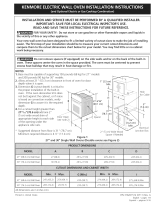
Notas importantes para eJ instaJador
1. Lea todas las instrucciones contenidas en este manual
antes de instalar el combination microondas /horno
de pared.
2. Saque todo e! material usado en el embalaje del
compartimiento de! homo antes de conectar el
suministro electrico o de gas a la estufa.
3. Observe todos los c6digos y reglamentos pertinentes.
4. Deje estas instrucciones con e! consumidor.
5. La puerta del homo se puede retirar para facilitar la
instalaciOn.
6. ESTE COMBINACtON MICROONDAS / HORNO DE
PARED NO ESTA APROBADO PARA LA
INSTALACION APILABLE O DE LADO A LADO.
Nota importante al consumidor
Conserve estas instrucciones y el manual del usuario para
referencia futura. No tirar las herramientas para retirar el
homo incluidas en la bolsa de la literatura.
IMPORTANTES DE SEGURIDAD
Aseg_rese de que su combinaci6n microondas /
homo de pared sea instalado y puesto a tierra de
forma apropiada pot un instalador calificado o pot
un t_cnico de servido.
Este homo de pared debe set electricamente
puesto a tierra de acuerdo con los cbdigos locales
o, en su ausenda, con el Cbdigo Electrico National
ANSI/NFPA No. 70-ultima edici6n en los Estados
Unidos, o el Cbdigo Electrico Canadiense CSA
Standard C22.1, Part 1, en Canad&.
Pisar, apoyarse, o sentarse sobre [a
puerta de este homo de pared puede causar serias
lesiones y daffos al homo de pared.
Nunca use su horno de pared para calentar una
habitad6n, El uso prolongado de la estufa sin la
ventilaci6n adecuada puede ser peligroso.
r_ La corriente electrica al homo debe
estar apagada mientras se hacen Jas conexiones de
I[neas, Si no seapaga, daffos serios o la muerte
podrian resultar.
1. Carpinteria
Consulte la Figura 1 para conocer las dimensiones pertinen-
tes al mode!o de su homo y a! espacio necesario en el que
poner e! homo. La superficie donde se va a apoyar e! homo
debe de ser de madera contrachapada s61ida u otro
material similar y, sobre todo, la superficie tiene que estar a
nivel, de lado a lado, y de atr4s hacia adelante.
2. Requisitos El ctricos
Este artefacto debe set suministrado con e! voltaje y la
frecuencia adecuados, y conectado a un circuito
individual correctamente puesto a tierra, protegido per
un cortacircuito o un fusible con el amperio anotado en
la placa de calificaci6n (la placa se encuentra en el
armaz6n del horno).
Cumpla con todos los c6digos en vigor y todos los re-
glamentos locales.
1. Para e! suministro electrico solamente se necesita
corriente con frecuencia de 60 Hz AC y fase 0nica de
120/208 o 120/240 voltios suministrada por cable de 3 o
de 4 alambres en un circuito separado con fusibles en
ambos lados de la linea (se recomienda un fusible de
tiempo retardado o un cortacircuito). NO ponga un
fusible en hilo neutro. El tama_lo de! fusible no tiene que
exceder la capacidad del circuito necesario para el
electrodomesticos y la cual se especifica en la placa.
2. El combinaciOn microondas/homo de pared puede
consumir un ma'ximo de 5200W cuando los dos hornos
esta'n funcionando. Use un disyuntor de 30 amperes con
un cable #8 AWG.
NOTA: El tamafio de los cables y de las conexiones debe
de estar en conformidad con el tamJlo del fusible y con la
capacidad del electrodomesticos y de acuerdo con el
C6digo Electrico Naciona! ANS!/NFPA No. 70 - Oltima
edici6n, o el C6digo Electrico Canadiense CSA Standard
C22.1, Part 1, y los c6digos y reglamentos locales.
No se debera usar extensiones para
enchufar este electrodomestico. Esto podria causar
un incendio, choque electrico u otto tipo de da_o
personal.
3. Este electrodomestico debe conectarse a la caja de
fusibles (o de cortacircuito), por medio de un cable
blindado flexible o un cable con forro no met_lico. El
cable blindado flexible que va desde el electrodomestico
debe de estar conectado directamente a la caja de
empalme. La caja de empalme debe de estar Iocalizada
en el lugar que se indica en la Figura 1, dejando tanto
exceso de cable como sea posible entre la caja y el
electrodomestico, de forma que asi e! electrodomestico
se pueda mover fa'cilmente, si fuera necesario para
hacer una reparaci6n.
4. Se debe de usar un conector que reduzca la tirantez de
una forma adecuada para unir el cable blindado flexible
a la caja de empalme.
En cuanto alas condiciones de despacho












